



Featured image: Reactor Halls E09: Psychotronic Reactors Ryan Jordan & Jonathan Kemp // Photo: Julian Hughes
Intro: Nathan Jones has his head bent by an evening of psychogeophysics and laboratory manufactured noise at Reactor Halls E09: Psychotronic Reactors, by Ryan Jordan & Jonathan Kemp, at Reactor’s new space in Primary, Nottingham. Photos by Julian Hughes.
Approaching an abandoned school in Nottingham as dusk fell, I hopefully considered a new subgenre of science fiction. After the Social-Science Fiction recently reinvented in the film work of Ryan Trecartin, perhaps then the Lab-Science Fiction of the psychogeophysicists. An authored art of reality, one that intrudes under the pretense of the experimental environment and appropriates the materially integral as theoretically freakish.
A red throbbing smoke seethes out of two open windows at the side of the building, blue and yellow light jumps across the window ledge, electric whip-cracks heard down a corridor.
This is the ambience of Kemp and Jordan, UK practitioners of ‘psychogeophysics’. The location is Primary, the new art space in Nottingham, home to art experience specialists Reactor and thirty of the city’s other independent art initiatives – but in the weekend evenings, all-but-abandoned. The eerie emptiness of the building lends itself to the increasing feeling of having slipped into a fiction.
I enter the old school through a side door, some lost parent in a nightmare, through an empty hall, on the verge of an integral, unfathomable assessment.
The background reading on psychogeophysics[1] is rich with conceptual freakery, based on the application of experimental conditions to pick up signals and messages from the spiritual other – such as the notorious Electronic Voice Phenomena experiments of Konstantin Raudive, which reportedly discerned the voices of the dead in electronic noise. The term psychogeophysics itself is a half-tongue-in-cheek addition to the always-already-playful ‘psychogeography’ adding to concerns with the summative effects of environment and mind on arts practice, with a pataphysical enquiry into the earth’s wave-spectrum effects as they impact on consciousness.
Kebab coagulates with tension, rises up like a deep brown lava-lamp fluid.
Kemp and Jordan, today’s psychogeophysics representatives, work at the edges of the believable, taking inspiration and theoretical modes from outside – through the discredited or unfashionable sciences of the mind and matter which proliferated in the 18th century – and projecting them into an experimental arts environments in the form of dystopian noise/rave-scapes.
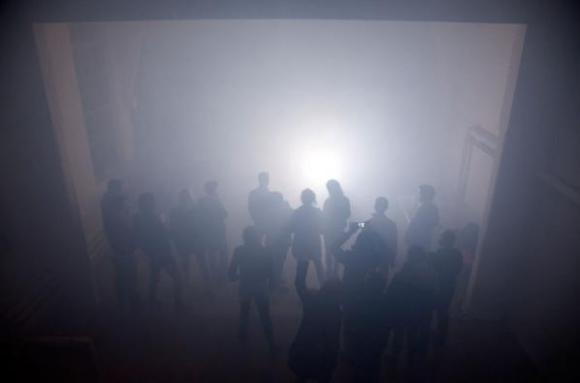
It’s a seductive atmosphere. But this isn’t a confidence trick, and the initial uncanniness is offset quite quickly by the manner of the artists themselves. Jonathan Kemp and Ryan Jordan have an approach which is the precise inverse of music-hall tricksters. Their diverse range of practices – taking in electronics and chemistry, installation, sound-performance, workshops – are unified around an obsessively open and unassuming approach, which is somehow difficult to reconcile with exotic conceptual grounding, and the promise of hallucinatory, out of body experience of the event. Throughout the evening, this integral conundrum between cynicism and being on the edge of discovery, plays out as a series of modesties, odd-ball crackpot demonstrations, chatty cigarette breaks, and noise abuse.
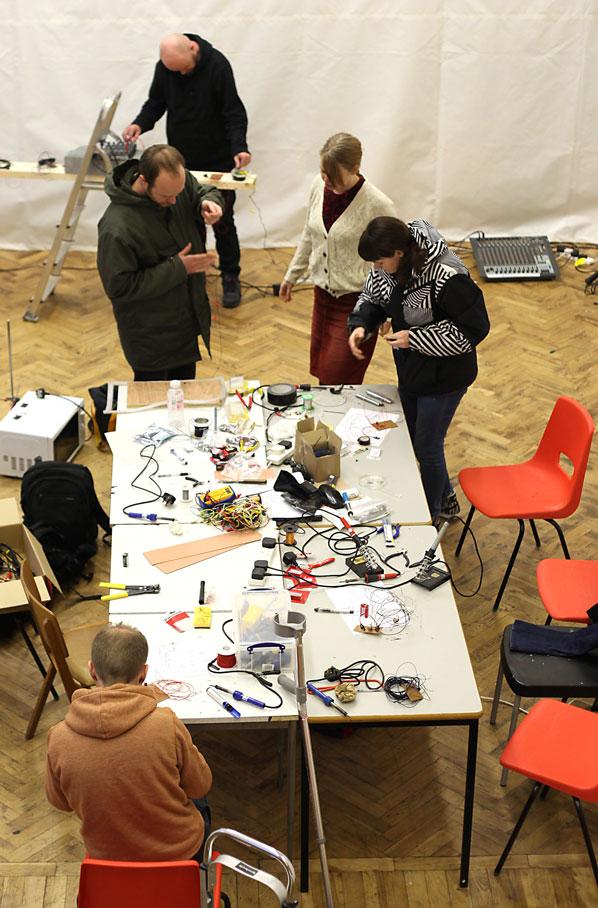
The basis for this evening’s bill was a laboratory workshop run by the artists, where participants – Nottingham based artists and Reator’s own esoteric cadre – could make their own devices with basic electronics – one for picking up electromagnetic waves, and another ‘solo-strobe’ unit which allows the user to stick two LED lights melted into lab glasses up close to their eye. It is these glasses that provide the first ‘performance’ moment of the night. We are invited to put the glasses on, and they are wired into the sound system, so each time the light goes on or off it makes a popping noise. Keeping our eyes closed, we can alter the frequency at which the lights flash on our eyes, and the resulting pulses or screams.
Blood strains in eye-lids. Crystaline salt remnants on pupil. Granular arrangement of optical receptors just before the brain. A familiar green and purple mesh which sieves the world into your soft-matter. Turning, the green grains mould together into white-hot orbs.
A pattern emerges where Kemp and Jordan take it in turns to set up and overload to breaking point a kind of ephemeral circuit between electronic equipment, geological objects, and our own nervous systems. Are we humans, or resistors?
The optical nerves, neuronal receptors and bodies of the audience are, to varying degrees of success, co-opted into a system of electro-magnetic flow across wires and solid matter – one which theoretical precursors might attribute to any number of things, from spirit-world contact, to the healing properties of rock, but that the artists themselves seem content to simply evolve and then break.
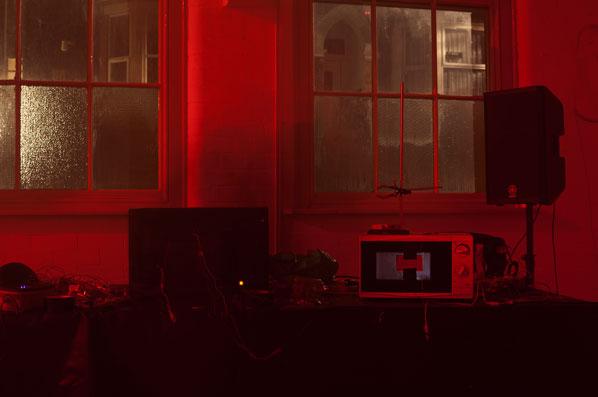
Jonathan Kemp puts tinfoil in a microwave that has a solar panel taped to it. He strings together a number of circuits made by workshop participants, and wires them to a large rock. There is the feeling of being part of something truly special and interesting, twinned with the feeling that an entirely intelligent and sane person might consider the whole evening to be some kind of elaborate joke on an unwitting reviewer. It isn’t a complementary train of thought to follow, and one which inevitably leads you to wonder whether the evening could be better presented. Why no introductions, no accompanying materials, no ‘show’? For a moment, I imagine my mum and dad standing in the centre of the small school hall demanding to know what is going on.
Back inside after a cigarette in the cracked and melted night, we are finally barraged with a single strobe light, by Ryan Jordan. There is a set of crystals set in front of the strobe also, so the electromagnetic pulses given off by them as innate response to the light stimulation, make the speakers pop and crack. The timing of light and sound is immaculate, and richly textured. Our own circuitry fully descended now from the cerebral, critical, suspicious human being, to a purely biological system, granulating, flipping on and off with the light and sound. Somewhere deep inside the purple matter a tiny voice wondering when it will end.
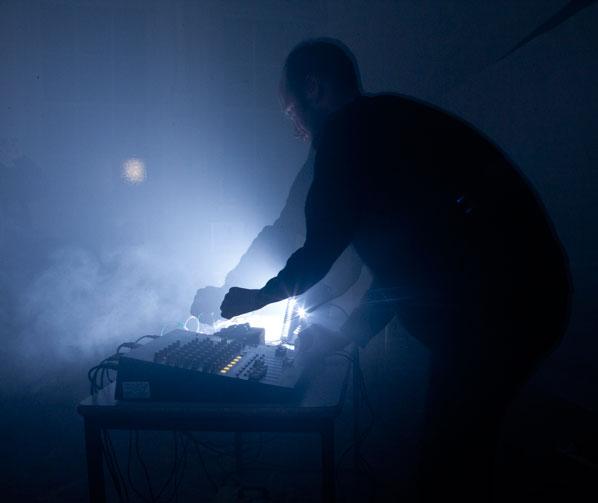
Rising, the mesh pulled upwards by the orbs distorting the front of the eyeball, pushing up at the iris like a small hot hand. The brain responds with a rumbling tide on its underside. The glitching and popping at the ears make your mouth turn up into a grimace.
Among the noise, the roughness and the seeming ambivalence of the artists towards the audience, a feeling of our own innate connection to the technological and chemical comes across very strongly. This connectivity is the hard-won evocation of two artists who have invested fully in the material consequences of their media, a feeling which has lasted well beyond the evening, for me. I did wonder though, whether this one successful evocation is dependent on the anti-showmanship of the artists, or in fact limited by the attention paid to the audience experience – a contrast which is especially stark given the context of the Reactor collective’s own portfolio of experiential arts environments. Perhaps not a new genre of sci-fi then, but a discipline that insists along with the noise practices of the last few decades, on the outer limits of entertainment.
Featured image: Radion at NetAudio London festival 2011.
NetAudio London Festival, 13th – 15th May 2011.
A three day festival that explores music environments in the digital age of networked technologies. http://www.netaudiolondon.org/
Marc Garrett interviews Andi Studer of NetAudio London, about their latest Festival at the Roundhouse and other venues in London, from Friday 13th – 15th May 2011. Showcasing work of artists who use digital and network technologies to explore new boundaries in music and sonic art, their festivals encourage participation in all forms: interactive sound art installations, conferences, workshops, collaborative online broadcasting and headline shows. This year promises to be a special event, headlined by the legendary Nurse With Wound and many more – read on.
Marc Garrett: This seems like an amazing festival. Not just because it’s context relates to my own background and Furtherfield’s own connected communities and its history in exploring an engagement of contemporary, networked creativity which was once perhaps, considered to be at the edge of art. But now, it does seem as if a new passion is alive and kicking, representing what exists across the genres of art, technology and social change.
The Netaudio London festival began its life in 2006, why did you chose to set up such a dynamic and involving festival, and who are your influences?
Andi Studer: The first Netaudio London grew out of a general passion for electronic music, combined with the recognition of a booming netlabel scene distributing new music with CC licenses for free download. Culturally it spanned the three fields of club culture, avant-garde music and net-politics. During the research phase, we came across of string of European festival projects with the same scope and decided to align with them, so after Netaudio Berne and Cologne, in 2005, London took it’s turn in 2006. Over 3 days we presented more than forty acts in club as well as gig settings; we hosted cultural discussions, organised a knowledge fair around digital music distribution and premiered an the audio installation by Si_COMM, S.E.T.I and N-Spaces… good old days!
MG: What do you feel is important about the Netaudio festival and how does the current one relate to contemporary culture?
AS: Netaudio aims to play an active role in the ongoing process of exploring how technologies, and particularly the Internet, shape our lives. Within this vast field, we focus our work on sonic culture, music and sound art, but reach out to wider aspects such as politics and protest or collaborative creativity.
Whereas in 2005/06 much of the cultural discussion was driven by an incredible optimism about new communication and distribution channels, this year’s festival may pick up on something best described as ‘cyber realism’. The festival, and particularly the conference, building on our 2010 research project, presents a strong case for individuals taking action. And in process of so doing, we are interested to explore what emerging digital tools they use to create new sound art/music, as well as in the social and political endeavours related to their creative work.
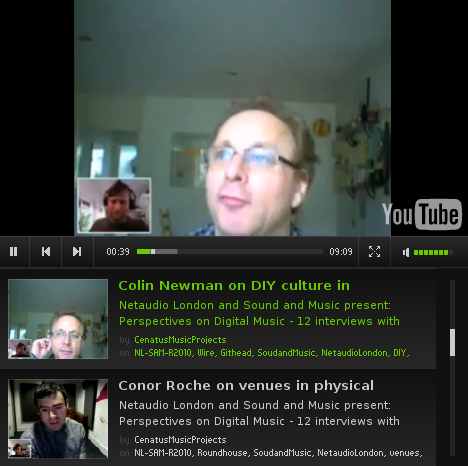
MG: Why chose to include those who have a history in net art, critically engaged thinkers invlolved in networked culture, and many who have been and are part of the (new) media art generation?
AS: We recognise a continuation of creative and socially aware work, enabled by network technologies. Including emerging as well as established projects, some dating from well before the WWW time, allows us to show this continuation and hopefully furthers the wider understanding of these different elements/groups. Whilst there are clear differences between them, there are also many overlaps and we hope that the inclusion of as many as possible in the debate and the wider festival allows for an exploration and greater understanding of these overlaps, and differences.
MG: Your festival includes a visiting member from UK Uncut who will be discussing with others at the Conference and Workshops, regarding the proposed theme of ‘politics and protest; creativity and collaboration; digital futures and analogue survivals.’ They have made headline news regarding their activities challenging the government’s ongoing cuts, and have been actively involved across the country targeting corporate tax dodgers and the banks who caused the financial crisis.
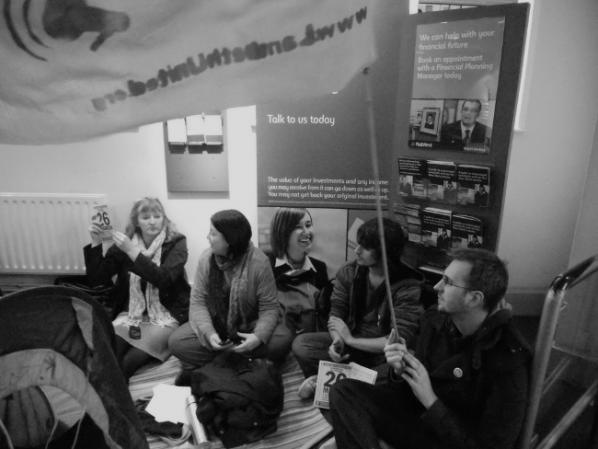
Do you think that UK Uncut’s own perceptions and its activism reflect the festival audience’s general interests and feelings on the matter, across the board?
AS: The participation of UK Uncut is confirmed, but the speaker is to be announced. Whilst some festival audience members may be sympathetic with UK Uncut’s perceptions and activism, others may not. Similarly, whilst members of the festival programming board may have sympathies with UK Uncut’s cause, the festival as such does not necessarily share the same cause with UK Uncut. The reason for inviting UK Uncut was their very successful work as a technology savvy protest movement, as well as their exploration of new forms of protest, particularly sit-ins involving poetry readings and the singing of songs. We are interested to find out more about how they use technology and music/sound in their cause. Presented in a panel with Jeremy Gilbert, Mark Fisher and Anthony Iles, we hope to show how their work sits within the incredible role music had and continues to have in social, political and economic protest.
MG: Nurse With Wound is headlining the festival and they are legendary in the underground music scene. Spanning a career of 30 years plus, under the curatorial guide of Stapleton who has seen NWW collaborate with a highly respected troop of free thinkers including David Tibet (Current 93), William Bennett (Whitehouse) and Andrew McKenzie (Hafler Trio). Many artists who have been working with technology and similar experimental genres, are influenced by those of industrial and avant garde music scene, such as Throbbing Gristle, Cabaret Voltaire, Virgin Prunes, This Heat and NWW, so it seems fitting to have them in the festival, with their peers and of course, an equally interesting selection of younger sound artists and musical explorers.
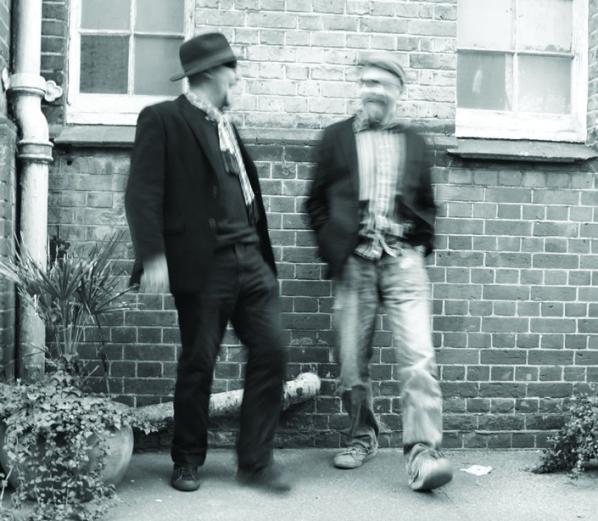
It may say seem like the perfect decision now, but how did you come to the idea of asking Nurse With Wound and what are the links with the other aspects of the festival?
AS: To have Nurse With Wound headlining our festival is a dream come true. Their achievements in anarchic, experimental, DIY, post-industrial music is unparalleled, and it is possible to find many of their approaches in the current new music produced by emerging musicians. This is something we hope to draw on in the rest of the festival.
At KOKO we will also present a newly commissioned live collaboration between Bruce Gilbert (ex-Wire) and Mika Vainio (ex-Pan Sonic). This opportunity to present new work came about though the direct continuation of an ongoing enquiry into collaborative creativity, as featured on one of the three conference panels. This is definitely also a strong theme in the work of Radian, the opening act at KOKO.
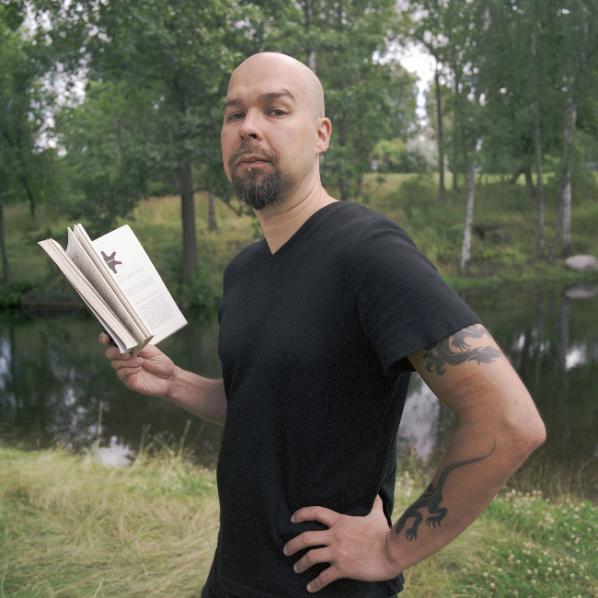
I’d urge anyone who is coming to see NWW at KOKO, to join us at the Roundhouse for the afternoon programme, particularly the conference, but also with the Open Platform stage, we hope to showcase some glimpses of the NWW legacy.
It may be worth mentioning the broadcast strand of the festival here too. Enabled by the Roundhouse Studio facilities and with creative input from Ed Baxter of Resonance104.4fm we are able to feed the festival back to the online domain for the first time. Throughout the afternoon of the 15th May, we will present a live web-zine, thereby leading an enquiry into the future of broadcasting. As part of this we will present three new pieces of work by the commissioned artists: Stefan Blomeier, VHS HEAD, and Liliane Lijn, the latter presenting an online adaptation of her Power Game project.
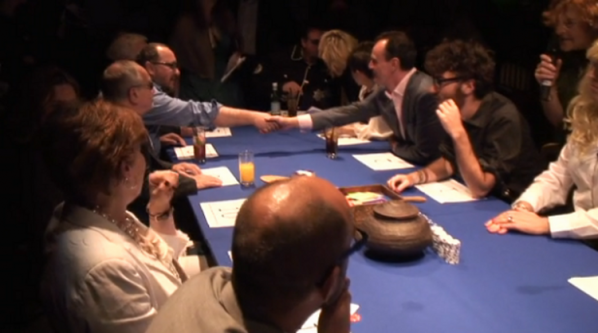
MG: This interesting development warrants investigation, not only because there is an an influx of new interest from a much larger informed and adventurous audience across the board but also because it represents an obvious, cultural dynamic at work. Reflecting a ‘real’ contemporary interest for something different to happen, beyond the remit of normative, art world restraints and its usual, hermetically sealed approaches. We will definitely be there ourselves. To experience what promises to be an engaging and critical conference, but also to explore and enjoy the other varied live events and projects.
The Conference – will bring together theorists, practitioners, activists and academics to address a challenging set of themes in 21st-century culture, featuring speakers including Matthew Herbert and Cecelia Wee: politics and protest; creativity and collaboration; digital futures and analogue survivals.
http://www.netaudiolondon.org/2011/strand/conference
Sound Art – In partnership with Call& Response Netaudio presents an event of 8-channel immersive audio-works. The dynamic and varied explorations of the nine prolific artists brought together by Call& Response highlights the vibrant and diverse field of contemporary sound art. Also there’s the Sonic Maze, an immersive series of sound art installations set in the Roundhouse Studios. http://www.netaudiolondon.org/2011/strand/sound-art
Broadcast – Using the format of a live webzine, Netaudio Broadcast will explore the future of broadcasting with a series of video and radio features. Netaudio Broadcast is co-curated with Ed Baxter of Resonance104.4fm. http://www.netaudiolondon.org/2011/strand/broadcast
Live Music – Starting at cafe OTO on 13th with Robert Piotrowicz (http://www.myspace.com/robertpiotrowicz) and Valerio Tricoli, continuing at Apiary with the runsounds hosted late night event; and the main live show of the festival, a rare live appearance from Steve Stapleton’s Nurse With Wound (http://en.wikipedia.org/wiki/Nurse_with_Wound), a special commission performance by Bruce Gilbert (ex-Wire) and Mika Vainio (ex-Pan Sonic) and Radian.
The 2011 Netaudio London festival supported by the National Lottery through Arts Council England and by the Austrian Cultural Forum London. It is presented in partnership with The Wire, ResonanceFM and Last.fm and supported by the Roundhouse and many more.